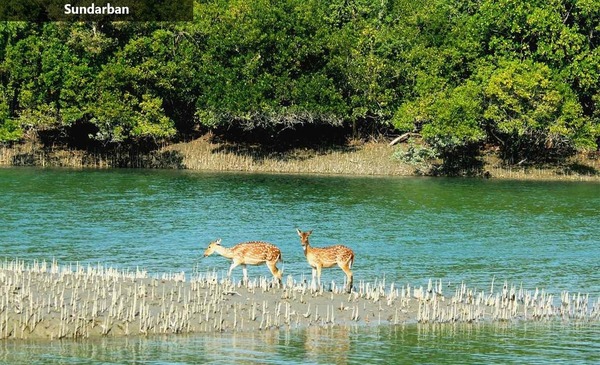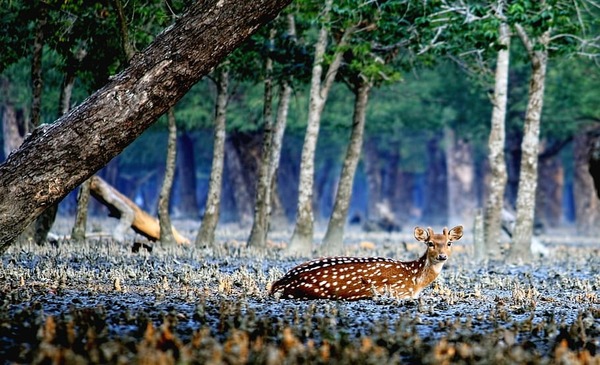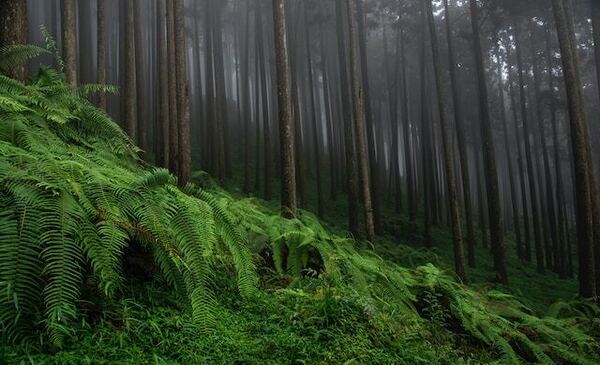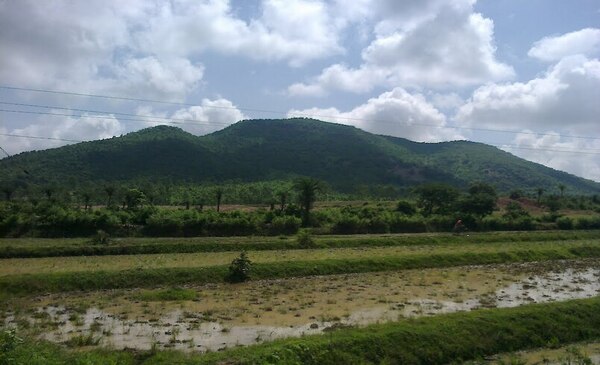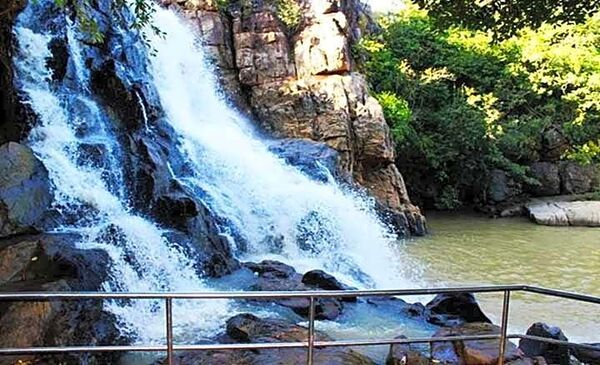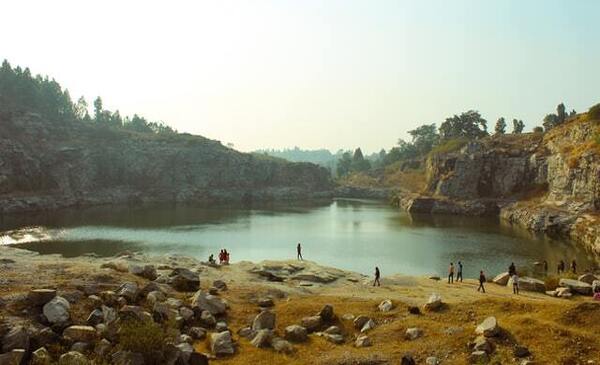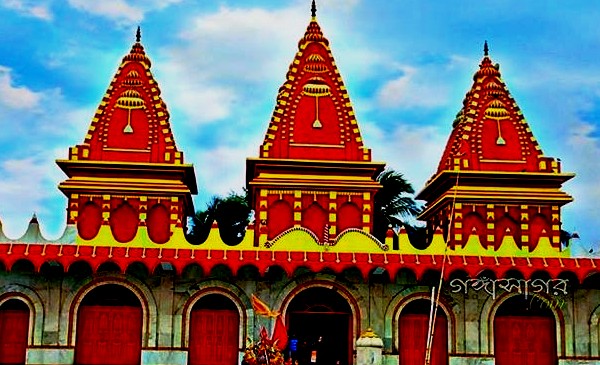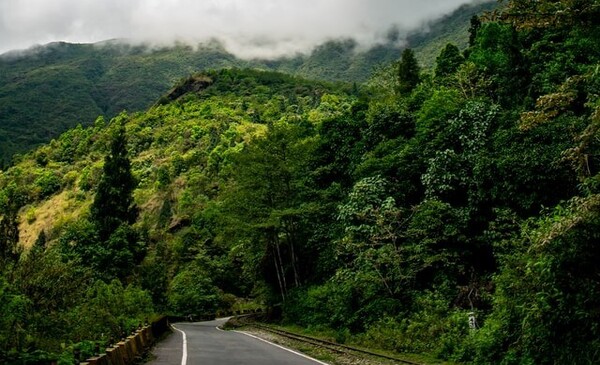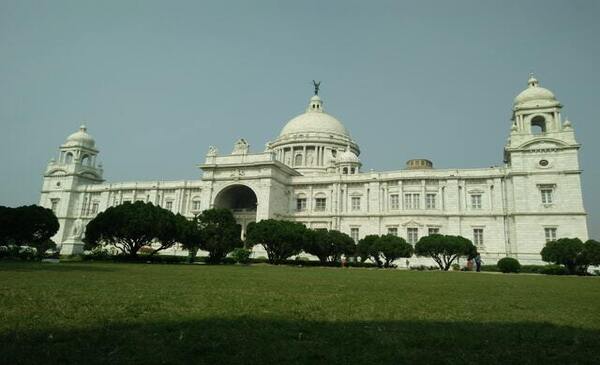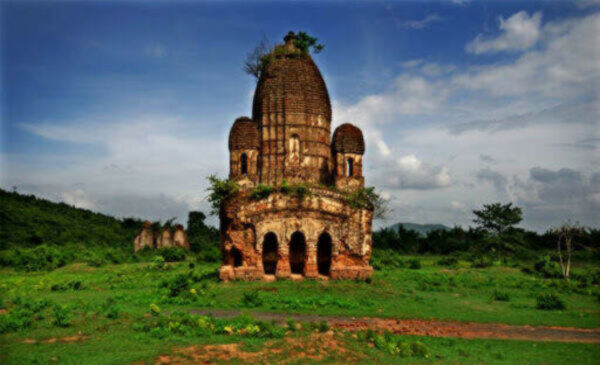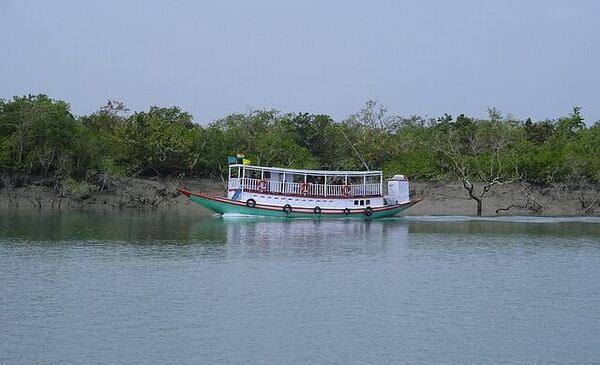Sundarban National Park
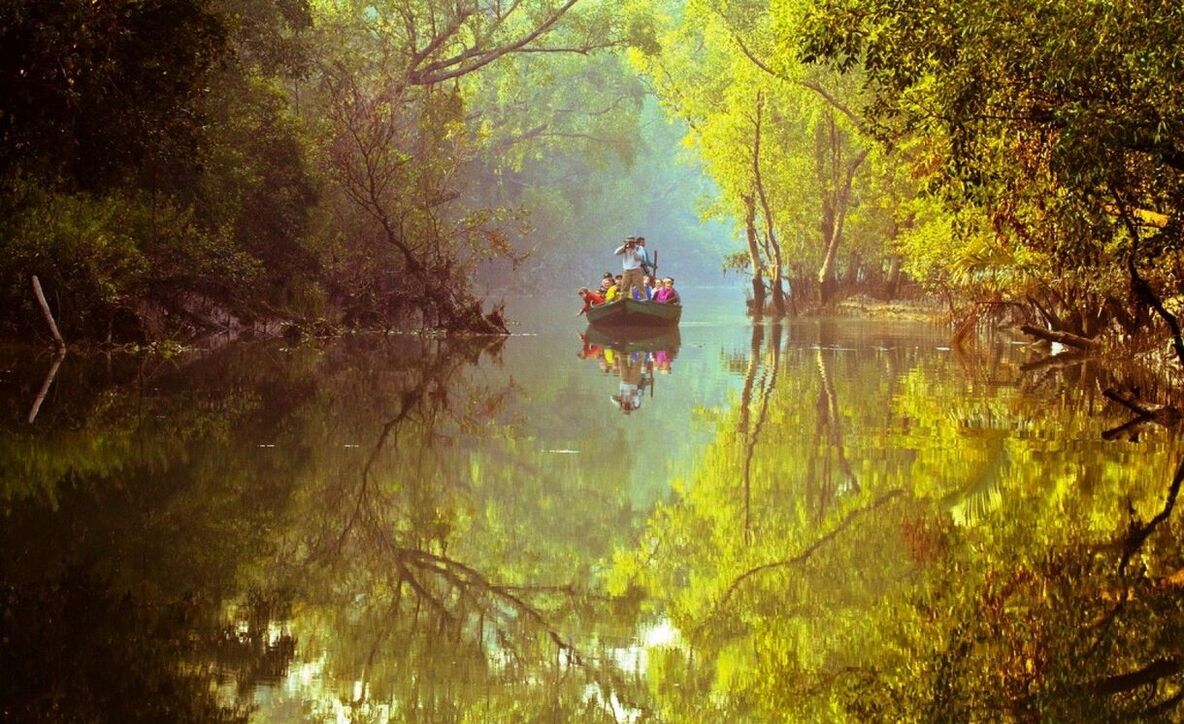
In Sundarban National Park in West Bengal, the tiger makes his around with a matchless sneakiness and gra1ce. The air feels damp, even as the quiet is intermittent by the melodic singing of birds and roar of motor boats. Inside these world’s biggest mangrove forests, creeks and tributaries form an involved method of networks. At times, they gather each other, and at others, wander off in a different place. Travelers out on a boat ride are given their money’s value as cross them. Even while you are unaware, the large cat and saltwater crocodile watch you at all times, watching each step you make. Though, sometimes, seem up, as there is act on the trees too. A diversity of birds, from Brahminy kite to whistling teals, call this their home, and declare that from time to time with a loud cry, song or chirp.
The Sunderban National Park is so many things at one time, a biosphere reserve, national park and tiger reserve; such is the fortune of this mangrove environment. What we normally call Sunderbans is in fact a big delta extends acrosswise 40,000 sq. km among India and Bangladesh! Just to give you a plan of how massive it really is, trust this. It stretches from River Hooghly in West Bengal, India, all the way to River Baleswar in Bangladesh. In this UNESCO World Heritage Site (it was declared a UNESCO World Heritage Site in 1987), the mangrove leaves stand slowly on the mudflats, which are able to be seen in low tides, and submerge in elevation tide. Its name means “stunning forests” in the local language, and it is not solid to figure why. Another reason is the Sundari trees, which are leading in this mangrove area. Their rareness lies in their roots which shoot upwards for respiration, mainly in water logging in monsoons.
A Short History of Sunderbans Tiger Reserve
The past times of Sunderbans can be traced as far back as 200-300 AD. It is thought that the forests of Sunderbans were leased to the close by residents in the Mughal phase, who build up settlements in them. In the upcoming years, however, those settlements were attacked by the Portuguese and salt smugglers in the 17th century. All that remnants nowadays are their ruins, most of which can be traced at a spot called Netidhopani.
It was in 1875 below the Forest Act, 1865 (Act VIII of 1865) that a big part of these forests were declared as “reserved”. Post-independence, it was confirmed a wildlife sanctuary in 1977 and established as a national park on 4th May, 1984. In the year 1978, Sundarbans were confirmed a national park, and in 1973, they were confirmed a tiger reserve under Project Tiger.
When to Visit Sunderban Park?
The great time to visit Sunderbans is among Novembers to March. The climate is rather enjoyable in this time and creates the ideal condition for tiger sighting and wildlife. You can also visit it in the summer period, or the months from April to July. Keep in mind though, that it can get very hot in this time, with the standard temperature being 43°C. Group of tourister find the warm up rather solid to pact with, but shouldn’t pose a problem for you if you are okay with it. Monsoons are not a best time to visit Sundarbans, as most of the areas are flooded and taking a boat ride would be rather not viable.
Geography of Sundarban Forest
Among other things, it is the rare geography of Sunderbans which endears it to the travelers. It is a division of the world’s biggest delta and home to the biggest mangrove forests. In its salty waters, mudflats and trees, reside an unbelievable diversity of flower and fauna. It is these, all-along with the vegetation that makes this location what it is, a secrecy which unfolds itself with each single visit. The huge Sunderbans also houses within it rivers, islands and villages.
Flora: Inside the wide forests of Sunderbans National Park reside a rich variety of flower. The 64 plant types which are establish however, have learned to stay lively in salty waters and salty flood. Some of the common types of plants which are set up take in Sundari tree, Golpati, Champa, Dhundul, Genwa and Hatal. It is probable that there are regarding 78 types of mangroves in these forests. They are very important because of the most important role they play in the endurance of sea organisms. From a distance, these halophytes give off an air of secrecy, who knows what the darkness within has to suggest.
Fauna: Wildlife seeing the sights is a major factor at the back travelers visiting Sunderbans, and properly so. After all, you’ve heard that it is home to a rich diversity of wildlife, with the Royal Bengal Tigers enjoying a big existence. Nothing makes the travelers more energized than a tiger sighting. As that splendid cat undoubtedly deserves all the interest and limelight, there are other types of birds and wildlife animals who call these mangrove forests their home.
Apart from the Royal Bengal Tiger, other animals set up in these areas are fishing cats, macaques, leopard cats, Indian grey mongoose, wild boar, flying fox, pangolin, and Indian grey mongoose. The chital deer and rhesus monkey are standard sightings.
Sundarban is also famous for its sea life, and is quite wealthy in it. A crocodile seated stress-free on a mudflat, basking in the afternoon sun, draws a range of reaction from watcher. Another than the saltwater crocodile, other type of aqua life take in red fiddler crabs and hermit crabs. As so many populaces may not be aware of it, but Sundarban National Park is house to a huge number of reptiles. A some of the more popular ones are water monitor, king cobra and rock python.
A types of river turtles called Batagur Baska (which are classified as endangered by the IUCN) are set up on the Mechau Beach. They are known by their little head, a snout which eternally goes upwards and an olive brown color carapace. The barking deer also deserve a rare mention, as it is establish at a place called Holiday Island.
Rivers: The Sundarbans delta is shaped by the upcoming together of three rivers, Ganga, Brahmaputra and Meghna. In addition these three most vital rivers, there are three other rivers which form an attractive network of channels.
Islands: There are numbers of islands dotting this part, and few of them are attraction in themselves. The most famous of them are Kalash, Henry and Netidhopani.
Villages: A numeral of villages lies in close immediacy to Sunderbans National Park like Pakiralaya, Dayapur, Bali and Sajnekhali. Village walks are popular among tourister as they suggest a fast look into the cultural lifestyle of the villagers. As visiting one of these villages, you can also look at the usual way of honey collection.

Safari Timing
Sunderbans National Park offers only boat safari to the guest. Jeep safaris are not conducted at this time. The safari timing is from 8:30 AM in the morning till 4:00 PM in the evening. The entry of boats later on than 6:30 PM is forbidden. As the park remnants open in the year, however, wintry weather time is the great time to visit it.
Where to Stay in Sunderbans?
Accommodation is hardly a problem in Sundarbans as there are wealth of hotels & resorts appropriate to your finances and preference. You can select from a variety of staying option from eco resorts and budget hotels to government run tourister lodges.

Sundarban Tiger Safari Resort
Pamper yourself with wonderful kindness and relaxed stay at Sundarban Tiger Safari Resort. This financial plan land in Sunderbans is one of the perfect hideouts for tourister to expend alluring holiday time in the area. Sundarban Tiger Safari Resort is simply available from the Canning Railway Station. Each cottage at Sunderbans Tiger Safari Resort is well furnished and ready with basic modern services like a comfy bed, attached bathroom and water bottle. This renowned resort in Sunderbans is built and designed maintenance the taste and comfort level of the visitors into thought. All-along with the perfect comfort, this staying choice in Sunderbans also ensures to offer the pleasing vision of the nearby, particularly in sunrise and sunset time. On the entire, Sundarban Tiger Safari Resort is one of those lodging choice in Sunderbans that are not just ideal to expend a family vacation but are also pocket-friendly.
Hotel Accommodation
As far as the lodging section is anxious, Sundarban Tiger Safari Resort has a total of 12 cottages. These cottages are well-adorned boasts a good interior and also take in vital current supplies. Not just this, the resort also ensures well-timed hygiene in order to proffer a easy stay to visitors.
Hotel Facilities and Features
There is a stretched list of services and features of Sundarban Tiger Safari Resort. The resort has its personal restaurant that serves some delicious delicacies. Separately from this, the another services at Sundarban Tiger Safari Resort are parking, room service, daily housekeeping, travel desk, power backup, pick up and drop and doctor on call.
-
Sunderban Tiger Camp
Sunderban Tiger Camp is a wonderful world in itself that helps you to give yourself a crack from the hustle and bustle of the current earth. Founded in the year 2004, Sunderban Tiger Camp is one of the most popular wildlife relieve resorts in Sunderban National Park. Shiny the local tradition and essence of the area, Sunderban Tiger Camp boats a rare design. Amidst the tranquil atmosphere and foreign wildlife, Tiger Camp is a quiet hideout for all the travelers who are looking for indelible holiday time in Sunderbans National Park. As you choose to have a live at Sunderban Tiger Camp, you are bound to enjoy the picturesque setting of the local area which comes as an appreciative treat. With new reduce, warm hospitality, nice services and unbelievable preparations, this eco-friendly resort in Sunderbans is reckoned between the peak places to stay in the area.
Hotel Accommodation
Sunderban Tiger Camp boasts a totality of four lodging categories – rooms, tents, bamboo huts and cottages. At first, the resort in progress with just the type of the camp which lead to the name – Sunderban Tiger Camp. All the rooms at Tiger Camp are rather large and with extended balcony. They are planned in a way to give the finest comfort to their guests. Keeping the modern wants of the guests, the accommodation also takes in a divide workplace. Not just this, the key highlight of these rooms is the vivid interior which includes hand paintings of local artists. Between all the rooms, 21 rooms are fully air-conditioned and are building up to supply the maximum calm to guests. The key attribute of these rooms is the attached bathroom which includes hot and cold running water.
Hotel Facilities and Features
All-Along with proffering a wonderful lodging, Sunderban Tiger Camp is also known for its equally enthralling additional services. The Fisherman’s jetty is the restaurant at Tiger Camp that serves some delicious local as well as international food. There is also a bar where one can expend his evening. The other necessary facilities that Sunderban Tiger Camp offers are intercom, ironing board (on request), travel desk, room service, parking, souvenir shop, car rental, boat rental, doctor on call, Wifi and conference hall.

How to Reach?
Sunderbans National Park, placeds2in 24 Parganas district all about 110 km from Kolkata, is well linked by train, air and road. Here is how you can arrive at it.
By Train: If you are travelling by train, get downhill at Sealdah Railway Station. Then, take a local train to Canning (this should take you about 2 hours). After than arriving at Canning, take a local mutual van which will get you to Godhkhali Jetty. From here, you can take a boat journey to Sunderbans.
By Air: The nearby airport to Sundarbans National Park is Netaji Subhash Chandra Bose Airport at Kolkata. After landing at the airport, you can arrive at Canning by a local train or car. The distance among the two is 54 km and the drive must get you all about 2 hours. Later than arriving at Canning, grab a local shared van towards Godhkhali Jetty. There, you will find boats waiting to take you to Sundarban National Park.
By Road: Start your drive to Godhkhali from Kolkata, a drive which should take you about 3 hours 30 minutes. After arriving there, take a ferry towards Gosaba. Once you reach, hire a cycle rickshaw to take you to Pakiralaya Village, situated on the other side of the island. From here, take another boat to Sajnekhali. You also have the choice of hiring a boat and going straight to Godhkhali (this ride should take you about 2 hours).
By Waterway: You can only reach Sunderbans by waterway after reaching Godhkhali. You can do that by hiring a car from Kolkata and driving all the way. Another way is to catch a local train to Canning from Sealdah Railway Station and then taking a local shared van to Godhkhali.

